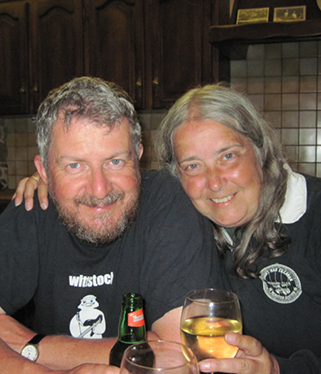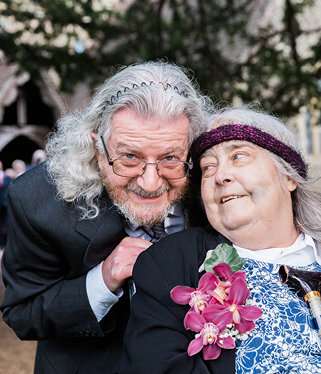Stephanie’s story
Shared by Stephanie’s husband, Ian.
The first real indication that something was wrong was when Stephanie set out on a dark, wet, mid-November evening to walk a few hundred yards to the village church. She came to her senses, soaked through, on a busy and dangerous country road half a mile away from her intended destination, having become completely disorientated. She managed to make a call for help on her mobile phone, and a search party had her back home, safe and warm, within an hour. The following morning her GP signed Stephanie off work for acute stress, but a day later she lost feeling and control in her left arm. Suspecting that she had suffered a stroke, her GP sent her straight to A&E where it was found that she had a significant growth within her brain. In early December it was confirmed to be an incurable Type 4 Glioblastoma tumour. She bravely elected to fight it, and had an operation to remove as much of it as possible on 19 December.
Stephanie came through the operation as well as could have been hoped, with all her faculties and personality intact, and returned home on Christmas Eve to set about recovery, with the promise of radiotherapy to come. She could shuffle about the house and managed to get back to knitting, though balance and walking any distance were still problematic. She had a fall in the hospital while attending an outpatient appointment on 3 January which turned into a day in A&E and set us back a bit, but she continued to make progress.
Meanwhile, we’d been making wedding plans and finally (after an engagement of thirty-three and a half years!) managed to get married on 14 January 2023 before a hastily arranged gathering of over a hundred friends, family and neighbours, making some happy memories in the midst of it all. Stephanie was determined that she would walk up and down the aisle in the church in spite of her illness. Not only did she achieve that, but she spent the whole afternoon, enthroned in her wheelchair, meeting and greeting every one of our guests.
The day before the wedding we had been in to the Churchill Hospital to have the tailored mask made for the radiotherapy which was due to start at the end of the month. Unfortunately, on 25 January the problems with Stephanie’s left arm came back – yet another day spent in A&E – followed the day after by a complex set of seizures and a blue-lamp run back into Oxford. It took several days in the emergency department at the John Radcliffe to identify a combination of drugs that would control the seizures, after which she was moved upstairs to a ward with a lovely view over the city. Stephanie was bedridden from then on; scans showed that the tumour had grown back and was still progressing, and the consultants decided that, unfortunately, further treatment was not possible, and she would now be moving on to palliative care.
The options for Stephanie’s palliative care were to move to a nursing home, a hospice or to go back to her own home. She was quite adamant that she wanted to return home, a prospect which I found extremely daunting. The hospital occupational therapists and I came to an agreement that the care package should include the maximum possible level of support. After several days waiting for the FastTrack funding to be approved, Stephanie came back home on 20 February with a package including a live-in carer, hospital bed and a raft of other equipment (which I’d somehow managed to make room for). After the cacophony of the ward, she enjoyed the peace and quiet back home with me and the cats (although with all her visitors, four visits per day from the basic carers, plus GPs, occupational therapists, district nurses and others, the place could get quite lively at times). Sadly, however, Stephanie became more poorly quite quickly.

Pictured: Ian and Stephanie on holiday in France

Pictured: Ian and Stephanie on their wedding day

Pictured: Stephanie staying at Sobell House
I have to admit that I found having Stephanie at home to be very stressful: the contracted live-in and visiting carers were lovely, but I had expected them to take a more pro-active role. We also had the support of our GP, the district nurses and the Palliative Care team at Sobell House, but it relied on telephone contact, with the district nurses’ visits in crowded schedules that didn’t always happen as promised. It was hard to know what questions to ask with so little knowledge. My mindset was focussed on looking after Stephanie for weeks or months to come, and I hadn’t realised that the reason I seemed all the time to be ‘firefighting’ increasingly difficult situations was that her condition was deteriorating so rapidly.
Stephanie was having more trouble with chewing and swallowing, with two frightening choking incidents, the second of which resulted in an emergency ambulance visit. Over the following days she became reluctant to take solids, and therefore began to miss some of her essential medications. Our GP set up revised prescriptions with her drugs in liquid form, and came out to see us the next day, by which time Stephanie wasn’t accepting fluids either. The GP called in the district nurses to set up a syringe pump to administer the drugs, and had me in tears of sadness, and relief, as she told me that I’d done all I could for Stephanie at home, and that it was time for her to go into full time nursing care and call her family over to see her.
Coincidentally, Alex, our Occupational Therapist from the Sobell House palliative care team, visited a couple of hours after the GP (for a previously arranged appointment intended to fit Stephanie up with a new wheelchair and to see about getting her out of bed with her hoist). Alex had seen the GP’s notes and could tell that things had worsened even over that short time. She took time to sit down with me and Stephanie’s mother and brother to explain what we were to expect over the next few days.
A short time later I received a call from the GP to say that the palliative care consultants at Sobell House had requested that Stephanie be brought in to them so she could receive the complex medications she needed to control her seizures, and that an ambulance had been booked. I now realised that they had been keeping an eye on us all along, even though I had felt so isolated at home.
That evening, on 15 March, we transferred back in to Oxford to Sobell House Hospice. Stephanie had gone off to sleep the evening before and never really woke up after that, though we did know (with finger squeezing and facial movements) that she was listening to what was going on at times. The final few days in the hospice were very peaceful for both of us and a huge relief for me; it was so comforting to be immersed in the beautiful environment and to have the support of all the staff surrounding us. I was able to stay in the room with her for the whole time (the nurses found me a nice big reclining chair), we had the TV and her brother brought in speakers so we could play Stephanie’s favourite music to her.
We’d had lots of visitors come to chat with Stephanie while she was at home and it was great to be able to continue taking visits while at Sobell House, even though she was no longer able to communicate.
For a while, as she neared the end, her breathing became very deep and laboured. The presence and expertise of the nursing staff through that period were greatly reassuring – it would have been so frightening to deal with at home. Fortunately, for her final twelve hours, she settled down to breathing gently and things panned out as well as anyone could have wished for: she slipped away quietly and peacefully, listening to Vaughan Williams’ Sea Symphony, on 18 March, exactly four months after her initial diagnosis.
Stephanie loved music and mathematics (she had a degree in maths from Somerville College). She was a computer programmer for much of her working life but spent the last seventeen years as a bookseller in the sheet music department at Blackwell’s, where her musical knowledge and IT skills were much valued. The church was packed for her funeral, which underlined what an inspiration she had been through her choral singing, leading the local choir, and giving piano lessons to young people in the village, as well as all the other societies and activities that she supported and helped to run. An inveterate crafter and reader, she leaves a legacy of knitted toys, pullovers, latch-hook rugs and a house full of books.
Looking back, being able to have Stephanie at home allowed us to fulfil her wish to see out her waking life there and at the same time eased the pressure on beds in Sobell House itself, meaning that a bed was there for her final few days when she really needed it.
Further to this story, Ian has met with our Lead Specialist Nurse, and we are reviewing the information we leave in the home for relatives.
If you would like to provide feedback on our services please do get in touch.
Thank you so much to Ian for kindly sharing his family’s experience of Sobell House.